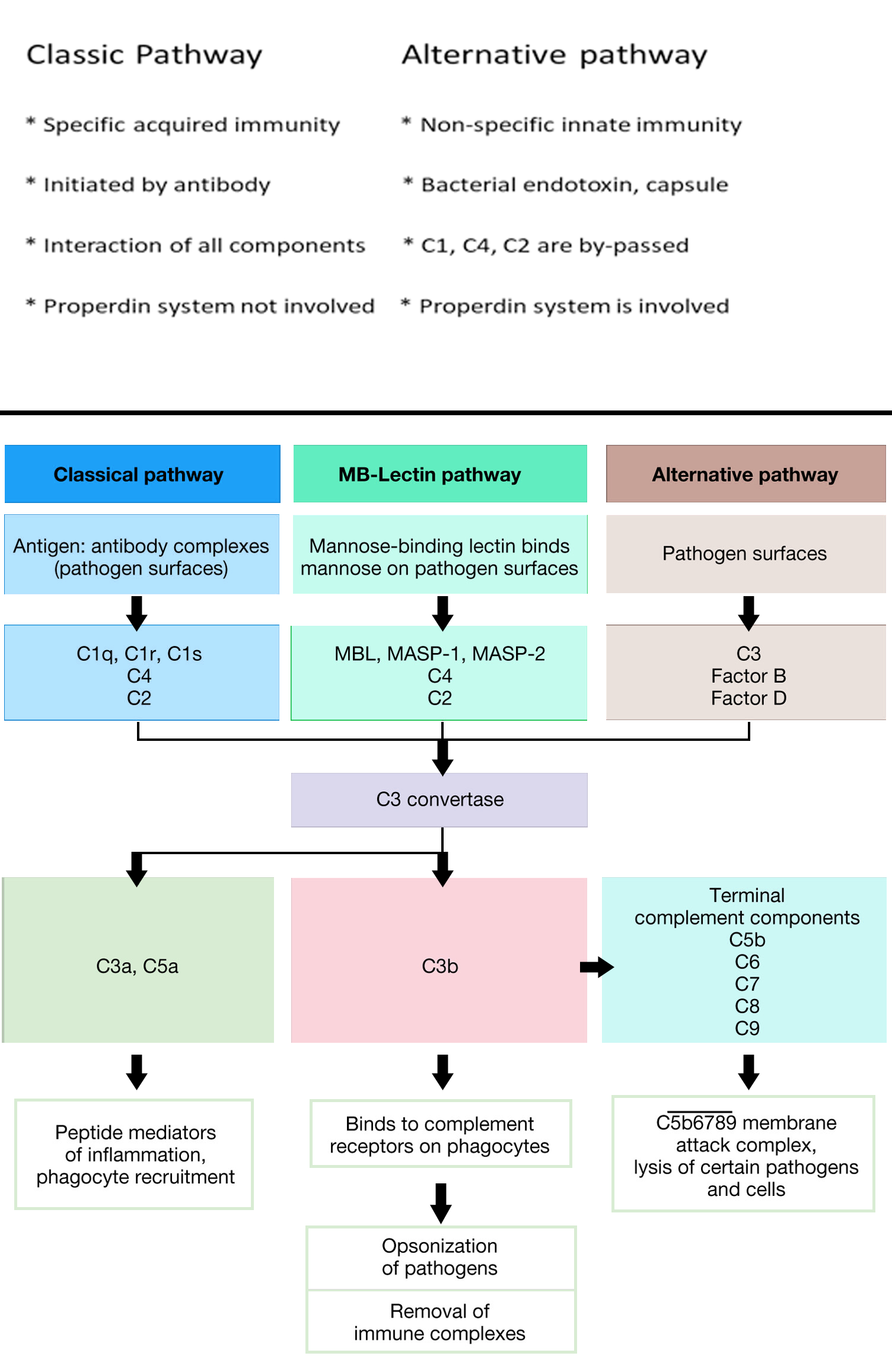COMPLEMENT
- Definition: series of heat-labile (56°C for 30 min), non specific serum proteins.
- Binds to Fc region of antibody-IgM (binds strongly) followed by IgG3à1à2
- Site: serum and all tissue fluids except urine and CSF
- Synthesis: In liver – C3, C6, C9 appear in fetal circulation during 1st 13 Week.
GIT- C1
Macrophage- C2, C4
Spleen- C5, C8
- Function: Responsible for certain aspects of immune response and inflammatory response
- Activation: antigen-antibody complex or endotoxin, capsule series of proteins activated sequentially
- Inactivation: inhibitors in plasma (short lived)
- Biological effects: either beneficial or harmful to host
Components:
- The complement system consists of at least 30 chemically & immunologically distinct serum proteins which make up the complement components, the properdin system & the control proteins.
- The biological activities of this system affect both innate & acquired immunity.
Fractions: Complement is a complex of 9 different fractions, C1-C9.
- Fraction C1 occurs in serum as a calcium dependent complex, which on chelation with EDTA yields 3 protein subunits called C1q, r and S.
- Thus complement is made up of 11 different proteins.
COMPLEMENT PATHWAY
- A) Classical pathway:
- - Complement is activated by antigen –antibody complex (IgM or IgG)
- - Fc portion of the antibody form a binding site for C1q
- - The numerical sequence of the complement factors in the classic pathway is:
- C1q, r, s , C4, C2, C3, C5, C6, C7, C8, C9
The reaction sequence divided into three stages:
1) Recognition stage:
- - C1q act as the recognition element
- - It binds to Fc portion of IgM or IgG
- - The activated C1 molecule can cleave many C4 molec.
2) Activation stage:
- The complement components C4, C2, C3, C5, C6, C7, C8, C9 participate in that order.
3) Membrane attack stage:
- Complement components C5, C6, C7, C8, C9 participate where cell membrane damage and cell lysis occur.
- B) Alternative pathway
This pathway is initiated by:
- Bacterial endotoxin, polysaccharide capsule, aggregates of IgE and properdin.
- It starts at C3 then C5, C6, C7, C8, C9.
- The complement compon. C1, C4, C2 are by-passed.
- Antibodies are not required to initiate activation of this pathway.
- This pathway provides a means of non-specific resistance.
- C) Lectin pathway
- Lectin pathway is also bacterial &fungal defense mechanism. Mannose binding protein (earlier RaRF), is a large serum protein that binds to non-reduced mannose, fructose & glucosamine on surface of bacteria & other cells.
- Microbial surfaces(mannose) & others ( e.g IgA) are needed. In this pathway, MBP resembles & replaces the complement C1q & binds to bacterial cells.
- On binding to bacterial surface, it activates the cleavage of MBP associated serine MBP associated serine protease cleaves the C4 & C2 components producing the C3 convertase which is the junction point of complement cascade.
Classic and Alternative pathways main differences.

Biological Effects of Complement
Beneficial effects:
1) Cytolysis:
- Activated complement proteins polymerize on cell surfaces of bacteria or erythrocyte to form pores in its membrane (killing by osmotic lysis).
2) Opsonization:
- Binding of complement proteins opsonin (C3b) to surfaces of foreign organisms or particles
- Phagocytic cells express specific receptors for opsonins, so promote phagocytosis
3) Inflammatory response:
- Small fragments released during complement activation have several inflammatory actions:
- C5a is chemotactic and attract neutrophils and macrophages.
- C5a activate phagocytes and neutrophils.
- C3, C4 and C5 are anaphylatoxins cause degranulation of mast cells and release of histamine and other inflammatory mediators.
4) Immune complex clearance:
- C3b facilitate binding of immune complex to several surfaces (erythrocytes) and enhance removal by liver and spleen.
- binds erythrocytes to blood vessels, make them as easy prey for phagocytosis.
- C3 deficiency associated with Immunocomplex disease and susceptibility to recurrent infections.
5) Enhancement of antibody production:
- Binding of C3b to its receptors on activated B cells (CR2) greatly enhances antibody production.
- Patient who are deficient in C3b produce much less antibody than normal individuals and more susceptible to pyogenic infection.
Harmful effects:
- If complement activate systematically on a large scale (Gm –ve bacilli).
- If activated by an autoimmune response to host cells.
Complement deficient states
|
Deficiency of complement
|
Syndrome associated
|
|
C1 Esterase inhibitor
|
Hereditary angioneurotic oedema
|
|
Early components of classical pathway (C1, C2, C4)
|
SLE & other collagen vascular disease
Pyogenic infection
|
|
C3 and its regulatory protein
|
Severe recurrent pyogenic infection
|
|
Complement C5-9 (membrane attack complex)
|
Gram –ve diplococci (Neisseria), Toxoplasma
|
|
D, I
|
Pyogenic infections
|
|
Properdin
|
Neisseria infections
|
|
H
|
Hemolytic uremic syndrome
|
